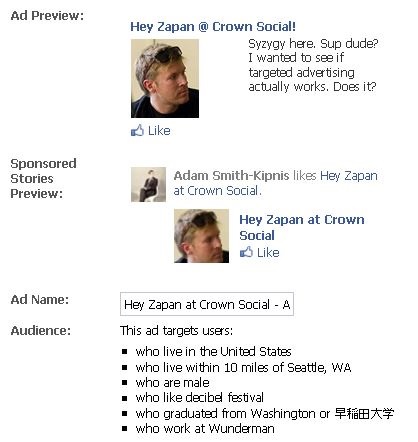I recently became more interested in the world of marketing. As such, I decided that I wanted to learn more about the nuts and bolts of targeted advertisement. As an experiment to see if targeted advertisement works, I started a project to get one specific person, and only that person, to click on a banner ad placed in Facebook. I spent a Sunday afternoon fixing a motorcycle in my garage, while meditating on who I would advertise to, and how.
One of my concerns was that I didn’t know who was using ad-blocking software and who wasn’t. I also didn’t want to invest in a micro-campaign if it wouldn’t give me results. I thought about posting an ad to one of my motorcycling companions, or perhaps a relative. I finally decided on my buddy Zach Huntting (AKA Zapan.)
Zach and I have been friends for a little over 10 years. We toured and performed together as part of the Fourthcity Laptop Battles, of which he was a founding member. Back in the day, I would tag along with him and help out with midnight wheatpasting campaigns for our shows. This resulted in several events sold to capacity, with lines stretching around the block.
Since then, Zach went on to get an MBA from the University Of Washington, and started his own social marketing firm called Crown Social. I figured that if there was anyone who wouldn’t be using an ad-blocker, it would be the guy that works in social advertisement. I opened his Facebook page in one tab, and the Facebook Ad Manager in another and started to build my campaign.
Setting up an ad campaign in Facebook took me less than an hour. I first created a page called “Hey Zapan At Crown Social” that included a photo of him that I pulled off the web. The thinking was that if I saw a picture of myself in an ad, along with a title that called me out by my nickname and my place of work, accompanied by a personal note from a friend, it would grab my attention and I’d click on it.
One of the neat things about Facebook is that they allow you to see the number of people in your target audience as you construct your ad. I found that one of the limitations is that they won’t tell you the exact audience number of people in your target audience if the list is fewer than 20 people. Even if the target audience is zero, it will still say fewer than 20.
I also had another issue including Crown Social as a place of work for my target audience. My guess is that the company doesn’t have enough employees yet to show up on Facebook’s radar. As such I added Wunderman to the list since it was in Zach’s work history. The UI for the Ad Manager made it unclear about whether my ad would be targeted at people actively working at Wunderman or people who included Wunderman in their work history. If there were no click-throughs in a few hours, I’d fine tune my ad a bit more. Facebook’s pricing was also a bit nebulous, as it didn’t give much information about the going rates for different types of ads.
 Eight hours after posting the initial ad, I only had one unique visitor to the page, and I was pretty sure that it was myself. I saw that Zach had been actively posting on Facebook earlier in the day without noticing the ad, so I decided to change the definition of my target audience a bit. I removed Wunderman, Decibel Festival and the University Of Washington, and instead focused on people who attended Waseda University in Japan and were also fans of the video game Hawken, a client of Crown Social. I figured that there could be only one person like that in Seattle.
Eight hours after posting the initial ad, I only had one unique visitor to the page, and I was pretty sure that it was myself. I saw that Zach had been actively posting on Facebook earlier in the day without noticing the ad, so I decided to change the definition of my target audience a bit. I removed Wunderman, Decibel Festival and the University Of Washington, and instead focused on people who attended Waseda University in Japan and were also fans of the video game Hawken, a client of Crown Social. I figured that there could be only one person like that in Seattle.
Two hours later, Zach posted to my ad page, calling it both hilarious and brilliant! In a total of 10 hours, I had successfully launched and completed my mini-campaign.


